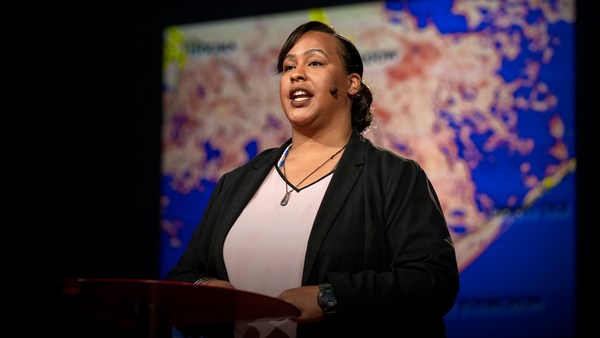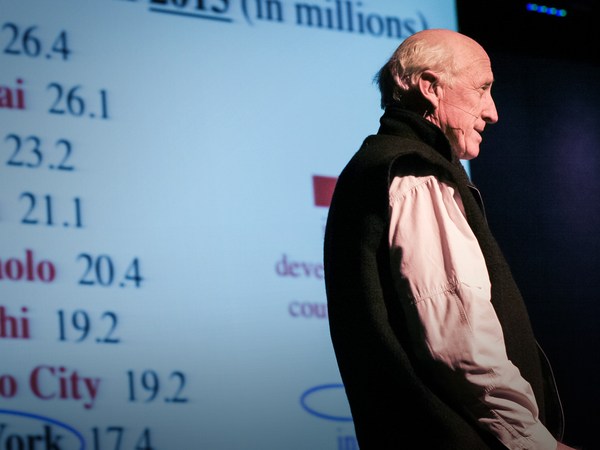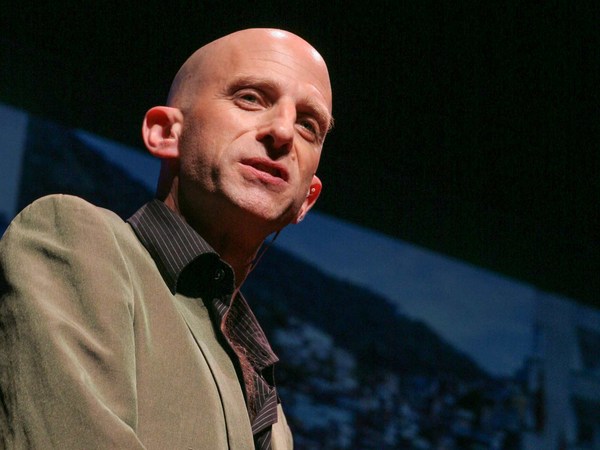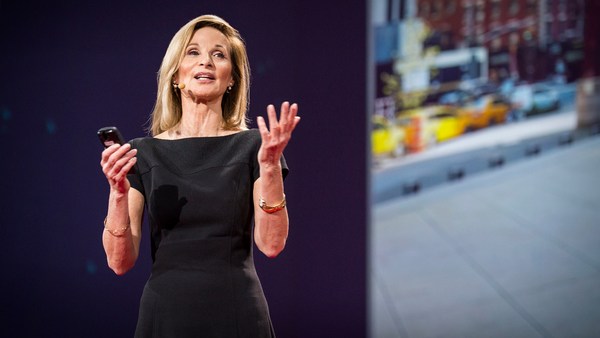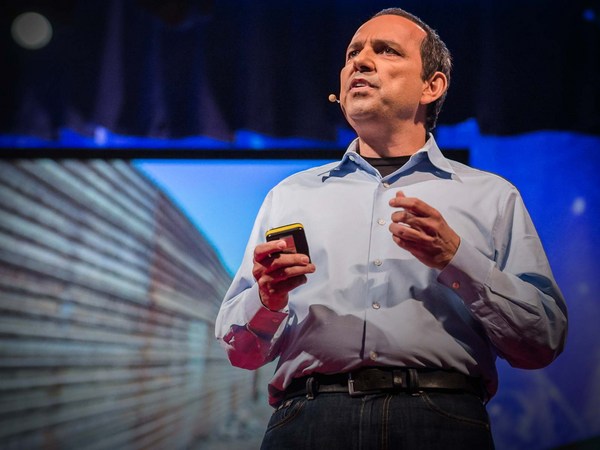What is our imagery of cities? When we imagine cities, we often imagine it to be something like this. But what if what you're looking at is just half a picture, but there is a city within the city. This part of the city is often seen as slums, squatters, informal, and people living here are called illegal, informal, criminals, beneficiaries, supplicants, etc. But in reality, these are poor people with no choices.
Poverty is a vicious cycle. If born poor, it can take three or more generations to escape one. Many are forced in this cycle without choices, to live on pavements, along train tracks, in dumping grounds, along rivers, swamps and many such unlivable spaces, without clean water, toilets or housing.
But these places are not unfamiliar to me, because since the age of six, I accompanied my father, a doctor, who treated patients in the slums of Bombay. Growing up, I would help him carry his bag of medicines after school lessons -- I loved doing that. Wanting to do something about these habitats, I decided to become an architect. But quite early on, I realized that the beauty of architecture was only for the rich. So I decided to do urban planning and joined an NGO in India that works with the urban poor who organize themselves to access basic services, such as water, sanitation and housing, for the poor living in cities.
Now I spent 10 years of my life in professional education, in learning, and then five years in unlearning it. Because I realized that all my training in architecture, design and planning failed ground realities. And this is where I learned the power of choice. I unlearned many things, but there are two myths about the poor that I would like to share that we live with.
The first myth is a perception that migration of poor people into cities is a problem. Is migration really a choice? My mentor Sheela Patel asked to those who think of this as a problem, "Go ask your grandfather where he came from," she says.
So what do poor people do when they migrate in cities? Let me share an example. This is the Mumbai International Airport. All that you see in blue are large informal settlements around it. Close to 75,000 people live here. So who are these people that work silently in hotels, restaurants, as laborers, babysitters, house helps and countless other jobs that we need for cities to function without a glitch? And where do they live? In most cities, they live in slums. So let us think again. Do we want poor people to stop migrating in our cities? What if they had a choice of not to?
The second myth is my personal experience. It's this attitude that we professionals know better. We professionals love to make choices for others, especially for the poor. Let me share an experience. In a workshop that looked at designing 250 new houses for poor families from a slum nearby, there were different building materials that were presented, ranging from papier-mâché, cardboard, honeycomb, etc., simply because they were affordable. But there was this one idea that was of shipping containers. Now we immediately approved of it, because we thought it was sustainable, scalable, affordable. But during this presentation, a lady from the slum humbly spoke up. And she asked the presenter, "Would you choose to live in it?"
(Laughter)
"If not, then why did you think we would?" Now this was a personal unlearning moment for me, where I realized that poverty only changes affordability -- it does not change aspirations.
Now poor people have lived in temporary structures all their life. They go from wall to wall, moving from bricks to tin. They move from building from bamboo, tarpaulin sheets, plastic, to cardboard, to tin, to bricks and cement, just like the way we do. So somewhere here, we were forcing our choices on them. So should we force our choices on them, or should we broaden their choices?
Now what if the opportunity to choose was given to people? These are women who lived on the pavements of a neighborhood in Mumbai. Now they faced constant evictions, and in response to it, they organized a women's network called Mahila Milan. Not only did they fight against evictions with those in power, saved money and bought land, but they also designed and helped construct their own houses. Well, these were illiterate women, so how did they do that? They used floor mats and saris to understand measurements. A sari is four meters in length and 1.5 meters in width. They used these simple day-to-day items to demonstrate house models. And even they made three options to choose from and invited all their fellow residents to come and have a look.
(Laughter)
And everybody loved this option that had a loft in it, simply because it did two things. One is that it accommodated larger families to sleep in. And two, it allowed home-based work, such as bangle-making, jewelry-designing, embroidery-stitching, packaging items, etc. Now they also decided to not have a toilet inside, but instead have it outside in the corridors, simply because it gave them more space and it was cheaper. Now, professionals could have never thought of something like that. A formal design would have necessitated to have a toilet inside.
Now these are smaller examples -- let me share some larger context: 881,000,000 people -- that's about one sixth of this world, as we talk here -- are living in slums and informal settlements. Almost every city in the global south has large slums in the size of townships. Kibera, in Nairobi, Dharavi, in Mumbai, Khayelitsha in South Africa, just a few. Now initially, they were all on waste and abandoned lands that cities were never interested in. As cities grew, poor people started building on these lands and brought value to this over time. And today, these lands have become real estate hot spots that everybody wants a piece of.
So how do cities and those in power choose to deal with them? They demolish them and evict them and move them away from their cities and economies in order to build a new infrastructure. They move them into vertical housing, which in reality looks like this. Now when built in high densities, they lack natural light and ventilation, and it often leads to unhealthy conditions.
Now, on one hand, poor people are not involved in the participation of design, and there is poor quality of construction. And on the other hand, they do not understand how to do maintenance, you know, keeping bills, keeping records, forming societies -- this is always difficult for them. And being forced to move into this formal society, they end up looking like this in a few years. Because formalization is not a product, it's a process. Moving from informal to formal for poor people is a journey. It takes time to accept and adapt. And when that choice is not given, it becomes like this, which I'm afraid, in future, these would become the slums.
Now instead of doing this, what if we accommodated poor people and gave them a choice to be a part of our cities and develop them where they are, giving them basic services, like in this picture? Now what happens if cities and governments could work together, if governments acknowledge poor people, and they could build it together?
This is Mukuru. It's a large informal settlement in Nairobi. It's one of the largest settlements in Africa. It's home to 300,000 people living over 650 acres of land. To help us understand that scale, it's like squeezing the population of Pittsburgh into the New York Central Park. That's Mukuru. So to give us a glimpse, this is the condition of housing. And this is what it is in between them.
So what is life in Mukuru like, just talking briefly? Five hundred and fifty people use one single water tap and pay nine times more than what anybody else in the city could pay, simply because there is no water infrastructure and water is sold. Many come back from work to find out that their houses do not exist, because they have either been bulldozed, or they have been burned down. So, tired of this situation, a local slum dwellers' federation called Muungano decided to do something about it. In four years, they organized 20,000 residents to collect data, map structures and put it together. And the plan was very simple -- they only needed four things. They wanted clean water, toilets, decent roads and, most importantly, not to be evicted.
So they presented this with the government of Nairobi. And for the first time in history ever, a city has agreed to do it. The city of Nairobi, the government of Kenya, declared Mukuru to be a special planning area, which means that people could come up with their own plan. People could decide to come up with their own norms and standards, because the standards that work for the formal citizens do not work in informal settings.
So what does that mean, to give us an instance? If these are roads in Mukuru, you can see that there are houses along both sides of the road. Now in order to bring in a city bus, as per the standards, planners would have gone for a luxurious 25-meter-wide road. Now that would mean displacing [25] percent of the structures -- that's a lot of people. So instead of doing that, we came up with a 12-meter-wide road, which had the structures intact and brought the city bus without compromising on much services.
In another instance, let's talk about community toilets. You know, in high-density areas, where there is no scope for individual toilets, like the public toilets that we have here. So we would go for a male section and a female section. But imagine this situation. In the morning rush hours to the toilet, when everybody is in intense pressure to relieve themselves, and if you're standing in a queue of 50 people, and there is a child standing behind an adult, who wins? Children end up squatting outside. And that's why women decided to come up with a separate squatting area for children. Now, who could have thought of something like that?
The idea here is that when poor people choose, they choose better. They choose what works for them. So choice is everything. And power decides choice. And we need those in power -- politicians, leaders, governments, architects, planners, institutions, researchers -- and all of us in our everyday lives to respect choices. Instead of choosing what is right for people, for the poor, let's acknowledge and empower their choices. And that is how we can build better and inclusive cities for tomorrow, completing the imagery of cities built by the choices of its own people.
Thank you.
(Applause)
